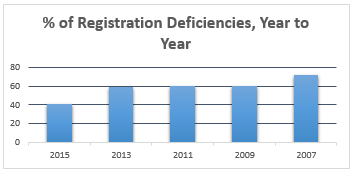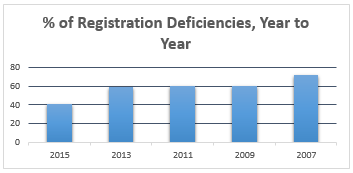Coordinated state exams conducted by members of the North American Securities Administration Association (NASAA) during 2015 uncovered the top registered investment adviser (RIA) compliance deficiencies across 20 categories. Last week, we discussed contracts-related investment adviser regulatory deficiencies, specifically related to fees, fee formulas, and improper execution. In this week’s installment, we cover another common RIA compliance deficiency category: registration.
The latest 2015 NASAA coordinated examination report shows that of the 1,170 investment advisory firms examined in 2015, 41.5% of firms with assets under management (AUM) had at least one registration-related regulatory deficiency. This figure is particularly notable due to the fact that there was a 17% decrease in this category compared to the results of the 2013 NASAA report and an 18.4% decrease compared to the results of the 2011 NASAA report. The table below summarizes the frequency of registration-related regulatory deficiencies from the 2007 to 2015 reports:

According to the 2015 study, about 45% of RIA firms with AUM less than $30 million had at least one registration-related deficiency compared to roughly 35% of investment advisory firms with greater than $30 million in AUM. Also notable, about 43% of firms with only one investment adviser representative (IAR) had at least one registration-related deficiency compared to around 38% of firms with more than one IAR.
The Chief Compliance Officer (CCO) of every investment adviser firm needs to be aware of the top registration-related compliance deficiencies that are outlined in this most recent report. In 2015, the top issues were:
- Form ADV- Inconsistencies between Part 1 and Part 2 (17.4%)
- Timely filing of amendments (12.8%)
- Form ADV- Fee structure (10.6%)
- Form ADV- Services provided (9.1%)
- Form ADV- Business Description (8.1%)
In 2013, the top issues were:
- Form ADV- Inconsistencies between Part 1 and Part 2 (13.5%)
- Form ADV- Fee structure (9.5%)
- Form ADV- Services provided (9.3%)
- Form ADV- Business Description (7.5%)
- Timely filing of amendments (6.9%)
Comparing the most recent 2015 summary to the 2013 and 2011 results, it’s clear that inconsistency between an RIA firm’s Form ADV Part 1 and 2 remains a very common registration-related compliance deficiency. In addition, there was an increase in 2015 in the frequency of deficiencies related to the timely filing of amendments. All investment adviser firms, even those just recently registered for the first time, are required to complete the annual RIA registration renewal process.
Investment advisory firms also need to remain vigilant around properly disclosing the firm’s fee structure along with a proper description of the services the firm provides. The Form ADV is the first impression that an RIA firm makes on a regulator and thus ensuring that the Form ADV is constructed and filed in a professional and compliant manner is essential. As RIA compliance consultants, we encourage the CCO of all investment advisory firms to take a few minutes to review their firm’s current Form ADV filings to ensure that the filings accurately reflect the firm’s current business practices.
